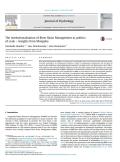In this paper, the authors explore the many successful strategies and measures for climate resilience and low carbon development that communities and leaders have pursued at the subnational level. They draw on the rich and practical experiences of CDKN’s project partners and the broader ICLEI network.
They argue that the battle for climate compatible development will be won or lost in provinces, districts and cities. There are distinct challenges at subnational level– for example, future climate data for local and subnational levels is more uncertain than at larger scales, and subnational decision-makers face intense local pressure to act on the negative impacts of climate extremes and disasters. There are also unique opportunities. Subnational decision-makers often have a sound understanding of climate trends in their area, based on first-hand experience and local and indigenous knowledge. They have a good sense of solutions that are effective in the local context and they have the ability to mobilise local resources for implementation, including people’s time and knowledge.
The 2012 United Nations Conference on Sustainable Development (Rio+20) emphasized the need for a balanced integration of the three dimensions of sustainable development. This publication responds to this call. It advocates a transformation in economic growth strategies and its underlying economic theories – a shift from a focus on quantity of economic growth, to quality of growth. Short-term growth strategies aimed at maximizing GDP growth has created a “vicious cycle” - growth driven by the exploitation of human and natural capital.
By the end of 2015, the United Nations will adopt a new global development agenda as a follow-up to the Millennium Development Goals (MDGs). To this end, UN member states are now engaged in a debate on defining universal Sustainable Development Goals (SDGs), as decided by the 2012 Rio+20 Summit. According to the final declaration of that summit, these goals should “address and incorporate in a balanced way all three dimensions of sustainable development and their interlinkages” and should “be coherent with and integrated into the United Nations development agenda beyond 2015” (§ 246).
There is more to sustainable forest management than reduced impact logging. Partnerships between multiple actors are needed in order to create the institutional context for good forest governance and sustainable forest management and stimulate the necessary local community involvement. The idea behind this is that the parties would be able to achieve more jointly than on their own by combining assets, knowledge, skills and political power of actors at different levels of scale. This article aims to demonstrate by example the nature and variety of forest-related partnerships in Brazilian Amazonia. Based on the lessons learned from these cases and the authors’ experience, the principal characteristics of successful partnerships are described, with a focus on political and socioeconomic aspects. These characteristics include fairly negotiated partnership objectives, the active involvement of the public sector as well as impartial brokers, equitable and cost-effective institutional arrangements, sufficient and equitably shared benefits for all the parties involved, addressing socioeconomic drawbacks, and taking measures to maintain sustainable exploitation levels.

River Basin Management (RBM) as an approach to sustainable water use has become the dominant model of water governance. Its introduction, however, entails a fundamental realignment and rescaling of water-sector institutions along hydrological boundaries. Creating such a new governance scale is inherently political, and is being described as politics of scale. This paper analyzes how the politics of scale play out in the institutionalization of RBM in Mongolia. It furthermore scrutinizes the role of the broader political decentralization process in the introduction of RBM, an issue that has so far received little attention. Finally, it assesses whether the river basin is an adequate water management scale in Mongolia.
